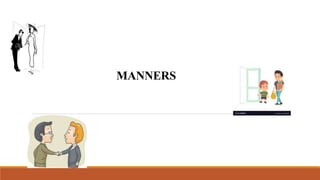Manners
•Télécharger en tant que PPTX, PDF•
0 j'aime•316 vues
These slides have been prepared by my students.
Signaler
Partager
Signaler
Partager

Recommandé
Recommandé
Contenu connexe
Tendances
Tendances (20)
Similaire à Manners
Similaire à Manners (20)
Reading Comprehension Chapter 6: Texts and Answers

Reading Comprehension Chapter 6: Texts and Answers
Plus de Mehvish Riaz
Plus de Mehvish Riaz (6)
Dernier
This presentation was provided by William Mattingly of the Smithsonian Institution, during the third segment of the NISO training series "AI & Prompt Design." Session Three: Beginning Conversations, was held on April 18, 2024.Mattingly "AI & Prompt Design: The Basics of Prompt Design"

Mattingly "AI & Prompt Design: The Basics of Prompt Design"National Information Standards Organization (NISO)
God is a creative God Gen 1:1. All that He created was “good”, could also be translated “beautiful”. God created man in His own image Gen 1:27. Maths helps us discover the beauty that God has created in His world and, in turn, create beautiful designs to serve and enrich the lives of others.
Explore beautiful and ugly buildings. Mathematics helps us create beautiful d...

Explore beautiful and ugly buildings. Mathematics helps us create beautiful d...christianmathematics
Dernier (20)
Mattingly "AI & Prompt Design: The Basics of Prompt Design"

Mattingly "AI & Prompt Design: The Basics of Prompt Design"
This PowerPoint helps students to consider the concept of infinity.

This PowerPoint helps students to consider the concept of infinity.
Unit-V; Pricing (Pharma Marketing Management).pptx

Unit-V; Pricing (Pharma Marketing Management).pptx
Beyond the EU: DORA and NIS 2 Directive's Global Impact

Beyond the EU: DORA and NIS 2 Directive's Global Impact
Web & Social Media Analytics Previous Year Question Paper.pdf

Web & Social Media Analytics Previous Year Question Paper.pdf
Explore beautiful and ugly buildings. Mathematics helps us create beautiful d...

Explore beautiful and ugly buildings. Mathematics helps us create beautiful d...
Manners
- 1. MANNERS
- 2. WHATARE MANNERS??? Way of behaving or acting in public Person’s way of behaving towards others The best way of behaving in society “Good Manners will open doors That the best education cannot.” (Clarence Thomas)
- 3. TYPES OF MANNERS Table manners Telephone manners Social manners Meeting manners
- 4. TABLE MANNERS Wait for everyone to be served. Do not talk with food in your mouth. Do not blow on your soup to cool it. Do not put too much food in your mouth. Don’t create chewing sounds.
- 5. TELEPHONE MANNERS When you are using phone, be polite and friendly. Lower your volume when talking in public and keep conversations as short as possible. Never drive and use phone at the same time. If you have sneeze or cough and you are attending a call, turn your head and cover your mouth. Introduce yourself, when required. Call back.
- 6. Manners to Use Cell Phones Avoid during a Meeting Avoid while Eating Avoid while Driving Avoid using in prayer areas Avoid speaking louder Avoid using at public places
- 7. SOCIAL MANNERS Greet people with a smile. Give up your seat on public transportation. Respect other people’s feelings. Open and hold the door for others. Always speak politely. Knocking before entering the room. Listen when others speak. Respect others’ privacy. Don’t ask personal questions.
- 8. Some Good Manners Passing Judgements and Comments is a Bad Habit Visiting a sick person Never go to a party empty handed Wait for your Turn
- 9. How to sit in front of others Sitting leg-crossed • Not confident • Good to sit With your friend • Bad to sit with boss and elders Sitting cross ankles • You have nothing to hide • Little bit confident • Feel secure Sitting Straight • Confidence • Good for interview • Good to sit with guests, strangers, boss and elders
- 11. Suggestion: Treat everyone with politeness, even those who are rude to you, not because they are nice, but because you are nice.
- 12. Politeness Politeness is described as a social norm, or a set of prescriptive social ‘rules’. Many linguists have aimed to research politeness, including Brown and Levinson (1987), who developed their ‘face theory’ based on the principles of our desire to be liked and to not be imposed upon. Positive politeness: Being friendly Doing favours to people Speaking to people in a familiar tone Negative Politeness: Having a neutral expression in public Using “please”, “if you don’t mind” and “thank you” a lot Not imposing on people 12
- 13. How to be Polite? Always use ‘please’ and ‘thanks Greet properly Pay Complime nts Use Appropriate language Compensate Respect others’ time
- 14. How to be Polite? Avoid Jargon Use Humour Be Punctual Apologize Face Reading Acknowle dgement
- 16. ANY QUESTION???
- 17. THANK YOU